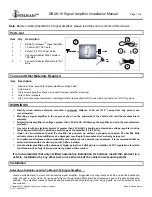
9
GHOST TONES
Ghost tones (aka “double tones”, “ghost notes” and “ghosting”) describes the phenomenon
of low-frequency notes occurring within the amplifier, underneath those you’re actually
fretting. Play through a fully-cranked, hot-biased Blackface Twin Reverb, or an early 50-
watt Marshall Plexi, and you will experience other-worldly, unique low tones, particularly
when soloing further up the neck.
These dissonant ghost notes appear to be completely unconnected to the “true” note, but in
fact they relate to the sums of differences between the frequency of the power supply and
the frequency of the notes being played.
Ghost tones are certainly undesirable when they become very loud and prominent (usually
indicative of faulty power supply filtering) but at lower levels they create a distinct vibe.
The effect can be quite subtle – as much a question of playing feel as sound – but it is
unquestionably part of the magic of these vintage amps, serving to thicken the overdriven
tone and reinforce lead lines.
The RevivalDRIVE generates ghost tones in exactly the same way as the classic amps of
the past. Turning the GHOST control clockwise reduces capacitance in the pedal’s
simulated power supply, creating more of the “ghosting” effect.
We’ve designed this control to offer a broad range of adjustment while never reaching the
extremes where ghost tones become undesirable. To do this, we examined the ghosting
behaviour of a number of classic amps including a pair of 1968 Marshall Plexi heads, a
pair of early 60's Fender Brownface amps, several mid 60's Fender Blackface amps and
various others. We found that our 1964 Vox AC30, as well as our 1967 Fender Twin, offered
the most pronounced ghosting. We then tweaked the GHOST control to go 30% further so
it can also be used to create a more overt effect.
As an additional twist, the RevivalDRIVE’s simulated mains power supply can be switched
between US and UK mains frequencies (50 and 60 Hz respectively, equating to 100 or 120
Hz once rectified) using the MODE DIP switch on the rear of the pedal. Changing the
power supply frequency alters the pitch of the ghost tones generated.
SAG: VALVE VS SILICON RECTIFIERS
In a valve amplifier, the power rectifier’s job is to convert AC mains power to DC. The
rectifier flips the negative portion of the AC sine wave to create a “bumpy” DC signal that
is subsequently smoothed out by the filter capacitors to create a relatively steady (though
still slightly wavy) DC supply.










































